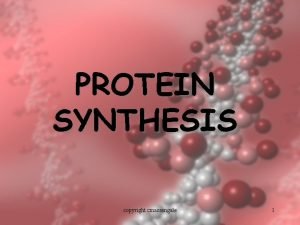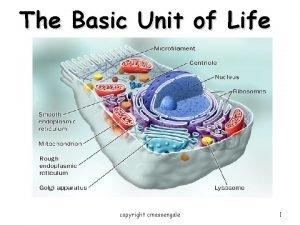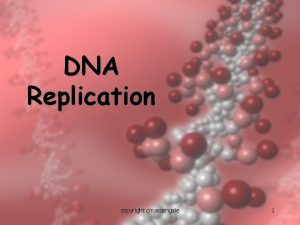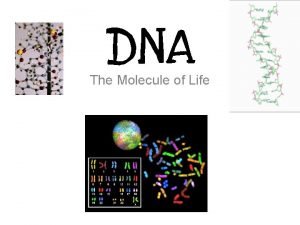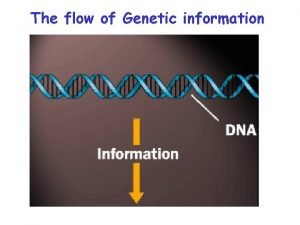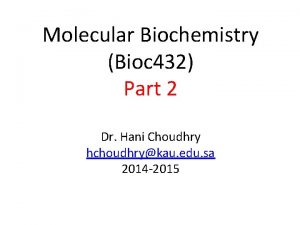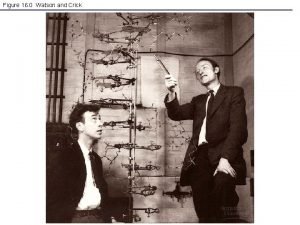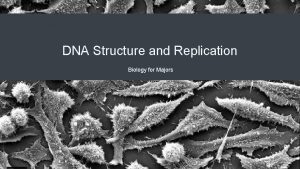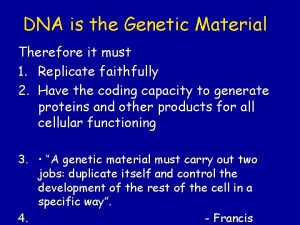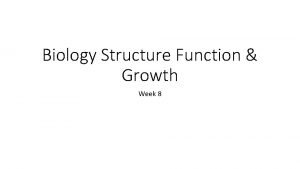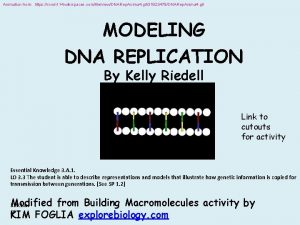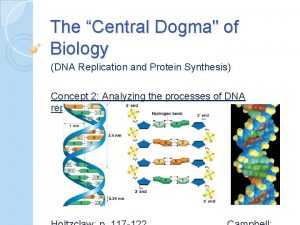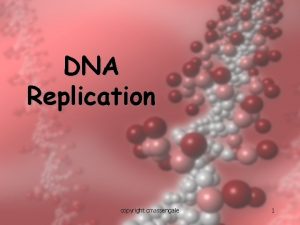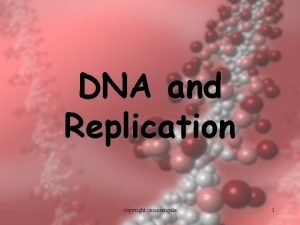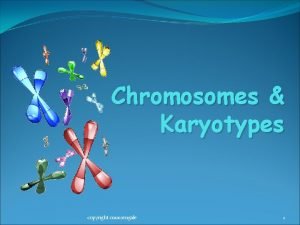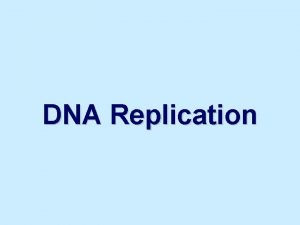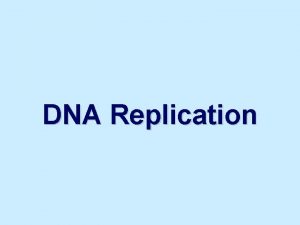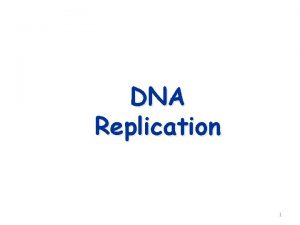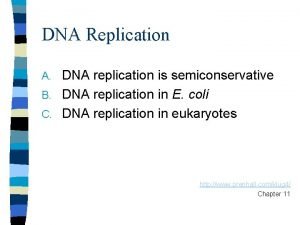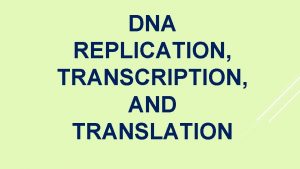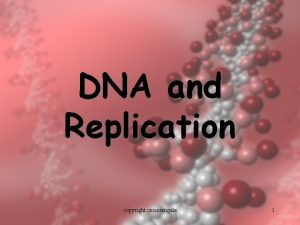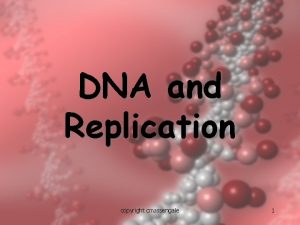DNA Replication copyright cmassengale 1 Replication Facts DNA




















- Slides: 20

DNA Replication copyright cmassengale 1

Replication Facts • DNA has to be copied before a cell divides • DNA is copied during the S or synthesis phase of interphase • New cells will need identical DNA strands copyright cmassengale 2

Synthesis Phase (S phase) • S phase during interphase of the cell cycle • Nucleus of eukaryotes S DNA replication takes place in the S phase G 1 interphase G 2 Mitosis copyright cmassengale -prophase -metaphase -anaphase -telophase 3

DNA Replication • Begins at Origins of Replication • Two strands open forming Replication Forks (Y-shaped region) • New strands grow at the forks 5’ Parental DNA Molecule 3’ copyright cmassengale 3’ Replication Fork 4 5’

DNA Replication • As the 2 DNA strands open at the origin, Replication Bubbles form • Prokaryotes (bacteria) have a single bubble • Eukaryotic chromosomes have MANY bubbles Bubbles copyright cmassengale 5

DNA Replication • Enzyme Helicase unwinds and separates the 2 DNA strands by breaking the weak hydrogen bonds • Single-Strand Binding Proteins attach and keep the 2 DNA strands separated and untwisted copyright cmassengale 6

DNA Replication • Enzyme Topoisomerase attaches to the 2 forks of the bubble to relieve stress on the DNA molecule as it separates Enzyme DNA copyright cmassengale 7

DNA Replication • • • Before new DNA strands can form, there must be RNA primers present to start the addition of new nucleotides Primase is the enzyme that synthesizes the RNA Primer DNA polymerase can then add the new nucleotides copyright cmassengale 8

copyright cmassengale 9

DNA Replication • DNA polymerase can only add nucleotides to the 3’ end of the DNA • This causes the NEW strand to be built in a 5’ to 3’ direction 5’ 3’ Nucleotide DNA Polymerase Direction of Replication copyright cmassengale RNA Primer 10 5’

Remember HOW the Carbons Are Numbered! Phosphate Group O O=P-O O 5 CH 2 O N C 1 C 4 Sugar (deoxyribose) C 3 2 C copyright cmassengale Nitrogenous base (A, G, C, or T) 11

Remember the Strands are Antiparallel 5 O 3 3 P 5 O O C G 1 P 5 3 2 4 4 P 5 P 2 3 1 O T A 3 O 3 5 O copyright cmassengale 5 P P 12

Synthesis of the New DNA Strands • The Leading Strand is synthesized as a single strand from the point of origin toward the opening replication fork 5’ 3’ Nucleotides DNA Polymerase copyright cmassengale 5’ RNA Primer 13

Synthesis of the New DNA Strands • The Lagging Strand is synthesized discontinuously against overall direction of replication • This strand is made in MANY short segments It is replicated from the replication fork toward the origin Leading Strand 5’ 3’ DNA Polymerase 5’ 3’ Lagging Strand RNA Primer copyright cmassengale 3’ 5’ 14

Lagging Strand Segments • Okazaki Fragments - series of short segments on the lagging strand • Must be joined together by an enzyme DNA Okazaki Fragment RNA Primer 5’ 3’ Polymerase 3’ 5’ Lagging Strand copyright cmassengale 15

Joining of Okazaki Fragments • The enzyme Ligase joins the Okazaki fragments together to make one strand DNA ligase 5’ 3’ Okazaki Fragment 1 Okazaki Fragment 2 3’ 5’ Lagging Strand copyright cmassengale 16

Replication of Strands Replication Fork Point of Origin copyright cmassengale 17

Proofreading New DNA • DNA polymerase initially makes about 1 in 10, 000 base pairing errors • Enzymes proofread and correct these mistakes • The new error rate for DNA that has been proofread is 1 in 1 billion base pairing errors copyright cmassengale 18

Semiconservative Model of Replication • Idea presented by Watson & Crick • The two strands of the parental molecule separate, and each acts as a template for a new complementary strand • New DNA consists of 1 PARENTAL (original) and 1 NEW DNA Template strand of DNA Parental DNA New DNA copyright cmassengale 19

DNA Damage & Repair • Chemicals & ultraviolet radiation damage the DNA in our body cells • Cells must continuously repair DAMAGED DNA • Excision repair occurs when any of over 50 repair enzymes remove damaged parts of DNA • DNA polymerase and DNA ligase replace and bond the new nucleotides together copyright cmassengale 20
 Bioflix activity dna replication nucleotide pairing
Bioflix activity dna replication nucleotide pairing Cmassengale
Cmassengale Cmassengale
Cmassengale Genus species
Genus species S phase
S phase Replication
Replication Dna and genes chapter 11
Dna and genes chapter 11 Haploid vs diploid
Haploid vs diploid Dna replication steps
Dna replication steps 3-5 exonuclease vs 5-3 exonuclease
3-5 exonuclease vs 5-3 exonuclease Okazaki fragments
Okazaki fragments Polyribosomes
Polyribosomes Dna structure and replication packet answer key
Dna structure and replication packet answer key Major enzymes in dna replication
Major enzymes in dna replication Antiparallel in dna replication
Antiparallel in dna replication Dna replication jeopardy
Dna replication jeopardy 3 models of dna replication
3 models of dna replication Missy baker
Missy baker Dna replication foldable
Dna replication foldable Nucleoside triphosphate in dna replication
Nucleoside triphosphate in dna replication Bioflix dna replication
Bioflix dna replication

